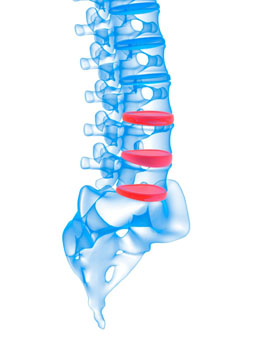Degeneration of intervertebral discs is a major health concern that arises with old age due to the wear and tear of spinal discs. Know more about this disease with respect to the causes, symptoms, diagnosis as well as the treatment options and precautionary measures.

Did You Know?
• 20% of teenagers show the presence of mild disc degeneration.
• 80% of the older adults show severe disc degeneration.
Degenerative disc disease (DDD) is the result of degeneration of the intervertebral disc(s) due to increasing age and the resulting wear and tear of tissues. Intervertebral discs or spinal discs are 7-10 mm thick, cartilaginous discs present between two consequent vertebrae. These discs provide flexibility, and perform mechanical functions like balancing and transferring the load arising due to body weight and muscle activity. Each disc is made up of a jelly-like material called
nucleus pulposus, surrounded by a thick ring termed
annulus fibrosus, which comprises layers of fibrocartilage.
Cervical and lumbar DDD are the two categories identified depending on the location of the degenerated disc. Although their etiology remains same, the symptoms may vary.
Given below is brief outline of the causes, symptoms, diagnostic aids and the treatments available to deal with this disease.
Causes
The intervertebral discs undergo maximum changes due to aging, in comparison with other connective tissues of the body. By the time you are in the late 30s, the amount of structural elements that comprise the discs changes, namely the amount of water, proteoglycans, and non-collagenous protein begins to decrease. On the other hand, the nucleus pulposus starts getting replaced by fibrocartilage. As a result, the boundary between nucleus pulposus and annulus fibrosus begins to blur. Such degeneration also leads to impingement of the nerve roots. Severe degeneration cases involve sciatica, annular tears (damage in the annulus fibrosus followed by leakage of the nucleus pulposus contained within), spinal stenosis and disc herniation.
Such degenerative changes may also result due to the following factors:
- Failure or reduction in nutrient supply to the disc cells
- Abnormal mechanical loads
- Injuries
- Genetic factors like mutations
Symptoms
Cervical DDD
- Neck pain
- Loss/Reduction of cervical ROM (Range of Motion)
- Pain running down the arm
- Tingling sensation in the arms
Lumbar DDD
- Chronic low back pain
- Difficulty in twisting, bending, sitting or getting up
- Pain while lifting objects
- Weakness and tingling in lower extremities
Diagnosis
- A physical exam is performed initially to understand the location and severity of pain, duration of symptoms and medical history.
- Imaging techniques like radiography help to identify structural deformities, bone spurs, height reduction and injuries.
- Advanced imaging methods, including magnetic resonance imaging (MRI) and computed tomography (CT), provide a more accurate diagnosis of the disc changes.
- Myelography and discography techniques, which involve the administration of contrast dyes followed by radiography that specifically outline the damaged areas, may be prescribed.
- An electrodiagnostic method termed electromyography may be advised for nerve conduction analysis, and to detect skeletal muscle weakness.
Treatment
Non-surgical methods to deal with disc degeneration include:
- Analgesics and anti-inflammatory medicines
- Traction
- Physiotherapy
- Exercise
- Chiropractic therapy
Either of the following surgical methods are used in cases characterized by extreme weakness and limitations in normal activities.
- Discectomy - Removal of herniated disc or a small part of the bone to free the obstructed or pinched nerves.
- Spinal fusion - Fusion of two or more adjacent vertebrae by removing the degenerated disc(s) and using bone grafts.
- Foraminotomy - Widening the neural foramen (space through which the nerve roots exit the spinal canal) to relieve the pressure on nerve roots.
- Corpectomy - Removal of part of vertebra and adjacent disc in order to decompress the spinal cord.
Precautions
The following simple but important habits can help to reduce the pain associated with disc degeneration:
- Maintain a correct posture while sleeping, sitting, using computers, etc.
- Consume a balanced diet and maintain a healthy weight.
- Indulge in mild exercise regularly.
- Be cautious while lifting objects and avoid sudden jerks.
- Sleep on a firm surface and lie on one side rather than lying on the back.
- Avoid smoking since it causes spinal cord ischemia (lowered blood supply to spine).
DDD is the leading cause for chronic back and neck pain in the adult population. It is a complex process that begins early in life, and is a consequence of aging as well as various physiological and genetic factors. It may lead to a chronic, debilitating condition, and may gravely impact the quality of life of the affected. Accurate diagnostic techniques combined with advances in genetic therapies, regenerative medicine and biomaterial studies serve as a reassuring hope to cope with the rising incidence of DDD.
Disclaimer: This Buzzle article is for informative purposes only, and should not be used as a substitute for professional medical advice.


 Did You Know?
Did You Know?